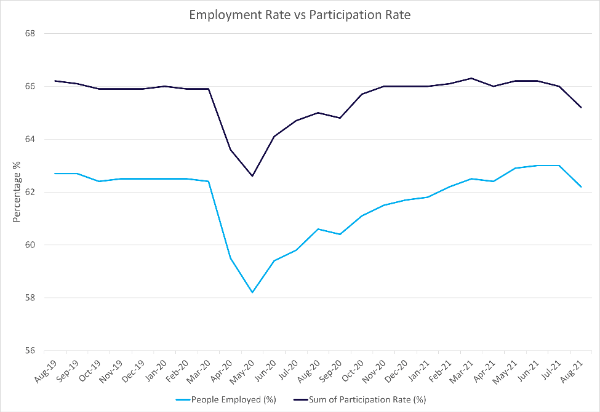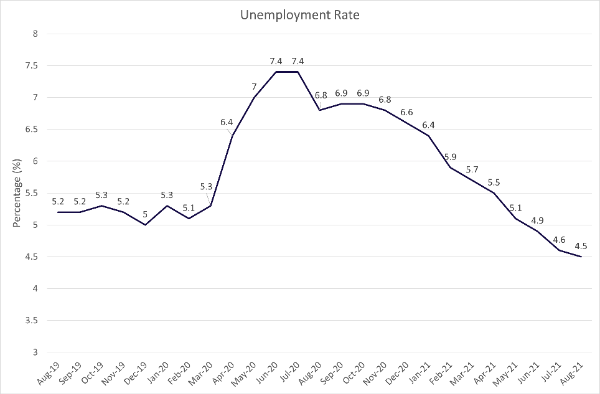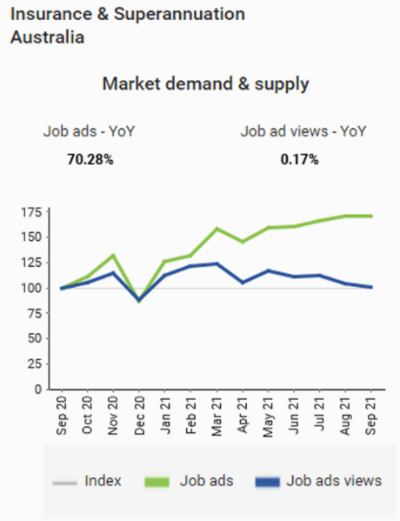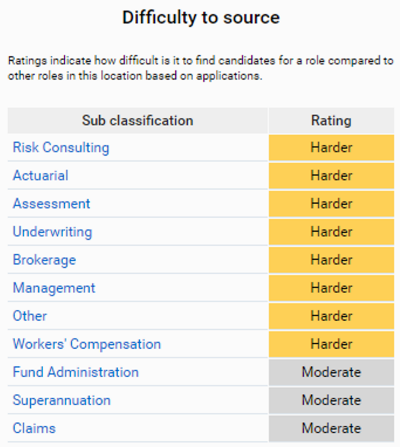Insurance’s employment market trends and how to navigate it to win talent
The war for talent in the insurance industry is a never-ending battle and, although we are nearing the end of the pandemic, there are no signs of relief to be seen. The last 18 months have caused candidate shortages across all industries as we’ve never seen before. A combination of factors has resulted in the…
The war for talent in the insurance industry is a never-ending battle and, although we are nearing the end of the pandemic, there are no signs of relief to be seen.
The last 18 months have caused candidate shortages across all industries as we’ve never seen before. A combination of factors has resulted in the candidate markets we all face today. These include:
- Recovery as businesses come out of the pandemic: An increase in job vacancies as businesses rehire or expand post-pandemic
- Trust created by COVID responses: Increased loyalty to employers among employees who their employers supported throughout the pandemic
- Security driven by COVID: Increased caution amongst employees to leave their jobs for new roles
- Supply through immigration: A decreased candidate pool size due to international border closures
For the insurance industry, however, the candidate short market is no new phenomenon. The pre-existing factors that have impacted the insurance industry well before the pandemic include:
Lack of pathways: There are no clear education pathways into the industry, which means fewer people pursue insurance as a career
- Improving staff retention: Strong staff retention strategies established by insurance businesses that have already been navigating the candidate short market for some time
What is the current state of the employment market?
The employment rate vs participation rate in Australia
The employment and participation rate are dropping. There is not enough data to make any clear conclusions, although the trend may allude to The Great Resignation, which experts warn is due to hit Australia in March 2022.

Source: Australian Bureau of Statistics, Labour Force, Australia September 2021
Unemployment rates and job vacancies in Australia
According to the ABS, unemployment rates are decreasing as businesses ramp up their workforce in efforts to grow and expand after the pandemic.New Paragraph

Source: Australian Bureau of Statistics, Labour Force, Australia September 2021
This is reflected by the increase in job vacancies in Australia.

Source: Australian Bureau of Statistics, Labour Force, Australia September 2021

Source: Australian Bureau of Statistics, Labour Force, Australia September 2021
According to SEEK, there is an increase in job advertisements posted in the insurance industry, while the number of job ad views is decreasing. The increasing gap in supply and demand is further evidence of the tightening of the candidate market in insurance.

Source: SEEK, September 2021
SEEK forecasts difficulty to source for the following roles based on the data above.

Source: SEEK, September 2021
The data below shows the increase in demand from businesses to fill roles in relevant sectors within the insurance industry.

Source: SEEK, September 2021
What can we see from the data?
The power is in the hands of job seekers. As job vacancies increase and candidate availability decreases, the gap between the two widens, giving candidates more control. Detrimental effects can already be seen in the industry. Here’s what we’re seeing:
- Candidates are increasingly accepting counter offers as existing employers are even more reluctant to lose staff in a candidate short market
- A larger number of job offers being declined with candidates considering multiple job opportunities at a time
- Businesses are raising salaries as part of their attraction and retention strategies
- Some candidates are using job offers as bargaining power/leverage to get pay raises and other benefits from their current employers
- Majority of hiring is coming from approaching the passive market (candidates who are not actively looking for a new role)
- The Great Resignation – as we come out of the pandemic, candidates reassess their priorities and seek new jobs that align. Read more about The Great Resignation here .
According to Employment Hero’s recent Employee Movement and Retention Report , the top three reasons employees are looking for a new role are lack of career opportunities, no pay raises and lack of appreciation or recognition.
The same report found the biggest priority for a job seeker is in fact, not salary increases. 41% of job seekers are actually looking for a job they enjoy over a pay increase. Other priorities include flexible working options, a location closer to home, a good company culture and a company that recognises and rewards its people.
What is the outlook?
Job vacancies
Job vacancy increases driven by significant government investment
We expect job vacancies to increase in the infrastructure and manufacturing industry. The government has promised to pump $15.2 billion into infrastructure over the next 10 years. We’re expecting to see related sectors, both directly and indirectly, benefit from infrastructure government funding too.
The pandemic has highlighted our need for more local manufacturing capabilities. The government announced last year that it would invest $1.5 billion into the manufacturing industry over the next 4 years.
Job vacancy rates in the retail, hospitality and tourism industries are also expected to spike as we ‘open up’.
Specific industry challenges
Some industry-specific challenges to consider that will impact upon job vacancy rates include:
- Continuous regulatory change and compliance obligations
- Claim events
- Technology advancements and changes
- New and emerging risks
- Other strategic considerations (e.g. offshoring and productivity)
Candidate Availability
Whilst immigration conditions will change, experts predict it will take until 2023 for Australia’s skilled migrant levels to return to normal. Lack of skilled immigration has eliminated an estimated 600,000 people from Australia’s workforce.
We are coming out of the pandemic at the start of the holiday period. As a result, we expect many people will leave for long-awaited holidays as borders reopen and travel restrictions ease.
There is also The Great Resignation to take into consideration. The questions we must ask are, “will people take their leave and go on holiday before resigning?”, “with many seeking jobs that better align with their new priorities, will the surge in job seekers from The Great Resignation be spread evenly between industries and role types?” and “will we have the attraction and retention strategies in place to navigate this event?”.
How to respond to the changes
The power struggle between job seekers and businesses in the insurance industry is not going away anytime soon. We must acknowledge that the candidate short market is not simply a result of the pandemic; it existed in our industry long before that.
Employers should consider the following to increase their chances of winning in the war for talent:
Identifying and exploring new candidate skills and pools
In a recent survey by Employment Hero, one-third of respondents who expressed they were looking for a job within the next six months were considering a role outside their current industry. This is an opportunity to diversify the skillsets of our current workforce and scout candidates we usually would not consider. Introducing new perspectives is key to innovation.
It can also be advantageous to hire from the passive candidate market – those who are not actively applying for jobs but may be open to leaving their current roles. There may be some work involved in reaching out to this market, so it’s worth reaching out to a recruiter who regularly does so. At Fuse Recruitment, we actively engage with the passive candidate market to let them know about any opportunities they might be interested in.
Increasing awareness of insurance as a rewarding career path
An alarming 50% of the industry’s workforce will retire over the next 10-15 years as over 60% of the current workforce are aged over 45. We expect many of these people will be in senior-level roles. With candidate shortages, mid-level managers will be promoted to fill vacancies, leaving and mid-level positions empty.
We need to encourage more young professionals to pursue a career in insurance by increasing awareness and creating pathing pathways into the industry.
As an industry initiative, Fuse Recruitment launched the Future Insure Graduate Program in 2018 to support the growth of the industry. The program has been designed to provide mid-sized insurance companies with the infrastructure to hire graduates via a program that teaches them about insurance and offers an opportunity for them to enter the industry.
We have seen a great response from our partners who have found that graduates are keen and have the aptitude for learning. Graduates have great attitudes and are the perfect solution where a role’s skills can be taught.
Enhancing attraction and retention strategies (Employer Value Proposition (EVP) and Talent Management strategies)
Some insurance businesses that have faced the candidate short market for a long time already have well-planned retention and attraction strategies. However, you’re playing a dangerous game if your business uses salary increases as its only strategy to attract and retain employees.
Eventually, your employees’ pay rates will be higher than their skillsets, and you will not be able to justify giving them a pay raise when they believe a pay raise is due. As mentioned earlier, pay increases are not the candidate’s top or only priority in a new role. Other factors need to be considered to develop a well-positioned EVP.
As part of your EVP, try to find ways to promote the culture of your business. You could share events in your business on social media and ask your employees to share to their own social media pages. Express the benefits you offer in job ads, and be sure to express these in interviews you have with candidates. Put yourself in the candidate’s shoes and consider the benefits as if you were looking for a job yourself.
As for talent management, it is handy to keep in mind the top three reasons people are currently looking for work (lack of career opportunities, no pay raises and lack of appreciation or recognition). Shape your business and find areas where it is possible to offer as much of these as possible.
If your business needs talent management solutions or requires help sourcing candidates in this candidate short market, reach out to us by filling in the form on this page. One of our consultants will get in touch shortly.







